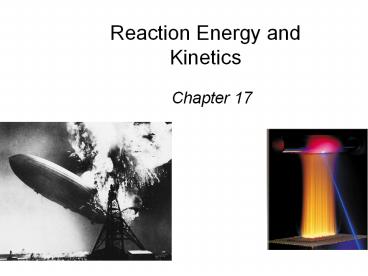Reaction Energy and Kinetics - PowerPoint PPT Presentation
1 / 13
Title:
Reaction Energy and Kinetics
Description:
Reaction Energy and Kinetics Chapter 17 Reaction Energy and Kinetics Chapter 17 Heat is the transfer of thermal energy between two bodies that are at different ... – PowerPoint PPT presentation
Number of Views:195
Avg rating:3.0/5.0
Title: Reaction Energy and Kinetics
1
Reaction Energy and Kinetics
- Chapter 17
2
Energy Changes in Chemical Reactions
Heat is the transfer of thermal energy between
two bodies that are at different temperatures.
Temperature is a measure of the thermal energy.
greater thermal energy
3
The specific heat (s) of a substance is the
amount of heat (q) required to raise the
temperature of one gram of the substance by one
degree Celsius.
The heat capacity (C) of a substance is the
amount of heat (q) required to raise the
temperature of a given quantity (m) of the
substance by one degree Celsius.
C ms
Heat (q) absorbed or released
q msDt
q CDt
Dt tfinal - tinitial
4
s of Fe 0.444 J/g 0C
Dt tfinal tinitial 50C 940C -890C
q msDt
869 g x 0.444 J/g 0C x 890C
-34,000 J
5
Constant-Volume Calorimetry
No heat enters or leaves!
6
Constant-Pressure Calorimetry
No heat enters or leaves!
6.5
7
Chemistry in Action
Fuel Values of Foods and Other Substances
1 cal 4.184 J
1 Cal 1000 cal 4184 J
8
Reaction Mechanisms
The overall progress of a chemical reaction can
be represented at the molecular level by a series
of simple elementary steps or elementary
reactions.
The sequence of elementary steps that leads to
product formation is the reaction mechanism.
N2O2 is detected during the reaction!
14.5
9
Intermediates are species that appear in a
reaction mechanism but not in the overall
balanced equation.
An intermediate is always formed in an early
elementary step and consumed in a later
elementary step.
- The molecularity of a reaction is the number of
molecules reacting in an elementary step. - Unimolecular reaction elementary step with 1
molecule - Bimolecular reaction elementary step with 2
molecules - Termolecular reaction elementary step with 3
molecules
14.5
10
Endothermic Reaction
Exothermic Reaction
The activation energy (Ea) is the minimum amount
of energy required to initiate a chemical
reaction.
14.4
11
A catalyst is a substance that increases the rate
of a chemical reaction without itself being
consumed.
ratecatalyzed gt rateuncatalyzed
14.6
12
The Rate Law
The rate law expresses the relationship of the
rate of a reaction to the rate constant and the
concentrations of the reactants raised to some
powers.
Rate k AxBy
reaction is xth order in A
reaction is yth order in B
reaction is (x y)th order overall
13
What is the equation for the overall reaction?
What is the intermediate?
NO3
What can you say about the relative rates of
steps 1 and 2?
rate kNO22 is the rate law for step 1 so
step 1 must be slower than step 2































